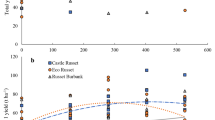Abstract
Russet Burbank and Shepody potatoes were grown with at-planting nitrogen fertilizer rates varying from 0 to 270 kg ha−1 following small grains and red clover. Petiole samples were collected from the 4th and 5th leaflets at four to six dates each during the 1986 to 1989 growing seasons. The samples were dried and analyzed for NO −3 N content. Petiole NO −3 N levels were strongly related to nitrogen rate regardless of cultivar, growing season, and cropping system. Differences among treatments and NO −3 N content varied substantially as the growing season progressed with petiole NO −3 N levels declining rapidly in underfertilized plots as the plants aged. Petiole NO −3 N levels were higher at midseason following red clover than following small grains. Sampling 50 to 60 days after planting (DAP) is most appropriate as a tool for scheduling supplemental nitrogen applications. At 50 DAP, critical petiole NO −3 N levels were 1.6 and 1.7% for Russet Burbank and Shepody, respectively. Petiole NO −3 N levels above 2.2% at 50 DAP resulted in lower yields of Russet Burbank than when petiole NO −3 N levels were in the 1.6 to 2.2% range. Petiole NO −3 N testing should be particularly useful as a diagnostic tool in management strategies which make maximum use of previous crop residues, organic amendments, and soil reserves as nitrogen sources.
Similar content being viewed by others
Literature Cited
Bundy, L.G., R.P. Wolkowski and G.G. Weis. 1986. Nitrogen source evaluation for potato production on irrigated sandy soils. Am Potato J 63:385–397.
Carpenter, P.N. 1957. Mineral accumulation in potato plants. Maine Agricultural Experiment Station Bulletin No. 562. 23 pp.
Doll, E.C., D.R. Christenson and A.R. Wolcott. 1971. Potato yields as related to nitrate levels in petioles and soils. Am Potato J 48:105–112.
Evanylo, G.K. 1989. Rate and timing of nitrogen fertilizer for white potatoes in Virginia. Am Potato J 66:461–470.
Gardner, B.R. and J.P. Jones. 1975. Petiole analysis and the nitrogen fertilization of Russet Burbank potatoes. Am Potato J 52:195–200.
Kleinkopf, G.E., G.D. Kleinschmidt and D.T. Westermann. 1984. Tissue analysis. A guide to nitrogen fertilization for Russet Burbank potatoes. University of Idaho Current Information Series No. 743.
MacMurdo, W., R.K. Prange and R. Veinot. 1988. Nitrogen fertilization and petiole nitrate testing in production of whole seed tubers of the potato cultivars Sebago and Adantic. Can J Plant Sci 68:901–905.
Millard, P. and B. Marshall. 1986. Growth, nitrogen uptake and partitioning within the potato (Solatnum tvberosum L.) crop, in relation to nitrogen application. J Agric Sci 107:421–429.
Millard, P. and D.K.L. MacKerron. 1986. The effects of nitrogen application on growth and nitrogen distribution within the potato canopy. Ann Appl Biol 109:427–437.
Nelson, L.A. and R.L. Anderson. 1977. Partitioning of soil test-crop response probability.In: Soil testing: Correlating and interpreting the analytical results. Agronomy Society of America Special Publication No. 29. pp. 19–38.
Porter, G.A. and J.A. Sisson. 1991. Rate response of Russet Burbank and Shepody potatoes to nitrogen fertilizer in two cropping systems. (In Press) Am Potato J.
Roberts, S. and H.H. Cheng. 1988. Estimation of critical nutrient range of petiole nitrate for sprinkler-irrigated potatoes. Am Potato J 65:119–124.
Roberts, S., H.H. Cheng and F.O. Farrow. 1989. Nitrate concentration in potato petioles from periodic applications of 15N-labeled ammonium nitrate fertilizer. Agron J 81:271–274.
Rourke, R.V. 1985. Soil solution levels of nitrate in a potato-buckwheat rotation. Am Potato J 62:1–8.
SAS Institute. 1985. SAS User’s Guide. Statistics, Version 5. SAS Institute, Cary, NC.
Terman, G.L., A. Hawkins, C.E. Cunningham and R.A. Struchtemeyer. 1951. Rate, placement and source of nitrogen for potatoes in Maine. Maine Agricultural Experiment Station Bulletin No. 490. 34 pp.
Timm, H., J.C. Bishop and V.H. Scweers. 1963. Growth, yield, and quality of White Rose potatoes as affected by plant population and levels of nitrogen. Am Potato J 40:182–192.
Tyler, K.B., O.A. Lorenz and F.S. Fullmer. 1961. Plant and soil analyses as guides in potato nutrition. California Agricultural Experiment Station Bulletin No. 781. pp. 4–15.
Tyler, K.B., F.E. Broadbent and J.C. Bishop. 1983. Efficiency of nitrogen uptake by potatoes. Am Potato J 60:261–269.
Westermann, D.T. and G.E. Kleinkopf. 1985. Nitrogen requirements of potatoes. Agron J 77:616–621.
Author information
Authors and Affiliations
Additional information
Maine Agricultural Experiment Station Publication #1517.
Rights and permissions
About this article
Cite this article
Porter, G.A., Sisson, J.A. Petiole nitrate content of Maine-grown Russet Burbank and Shepody potatoes in response to varying nitrogen rate. American Potato Journal 68, 493–505 (1991). https://doi.org/10.1007/BF02853766
Accepted:
Issue Date:
DOI: https://doi.org/10.1007/BF02853766



